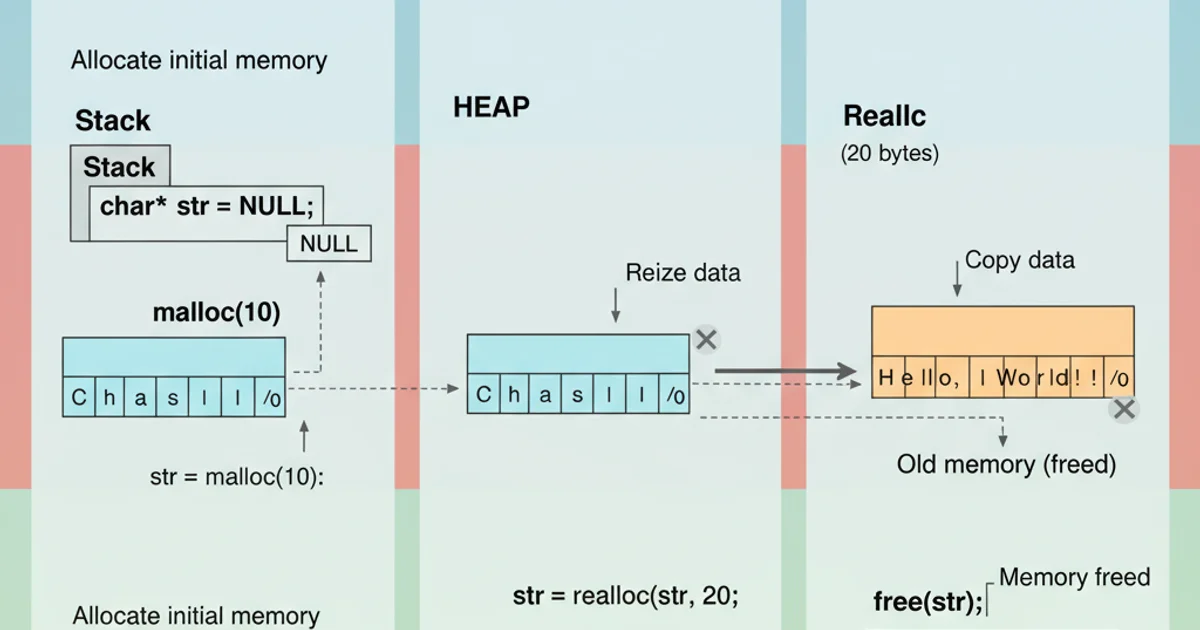Arbitrary length string in C
Categories:
Mastering Arbitrary Length Strings in C

Explore techniques for handling strings of dynamic and arbitrary lengths in C, overcoming the limitations of fixed-size character arrays.
Unlike many modern languages that offer built-in dynamic string types, C requires manual memory management for strings whose lengths are not known at compile time. This article delves into the fundamental concepts and practical approaches for creating, manipulating, and managing arbitrary length strings in C, focusing on dynamic memory allocation and common pitfalls.
The Challenge of Fixed-Size Arrays
In C, strings are typically represented as null-terminated arrays of characters. While convenient for fixed-size strings, this approach quickly becomes problematic when dealing with user input, file I/O, or network communication where string lengths can vary significantly. Declaring a char buffer[100]; might seem sufficient, but it introduces risks of buffer overflows if the input exceeds 99 characters (plus the null terminator), leading to security vulnerabilities and program crashes.
#include <stdio.h>
#include <string.h>
int main() {
char fixed_buffer[10]; // Can hold 9 characters + null terminator
printf("Enter a string: ");
scanf("%s", fixed_buffer); // Unsafe: No length check
printf("You entered: %s\n", fixed_buffer);
return 0;
}
Example of a fixed-size buffer, prone to overflow.
scanf("%s", ...) without specifying a maximum width is extremely dangerous and should be avoided. Always use fgets() or scanf("%9s", ...) to prevent buffer overflows.Dynamic Memory Allocation for Strings
The solution to arbitrary length strings in C lies in dynamic memory allocation using functions like malloc(), calloc(), realloc(), and free(). This allows you to allocate memory on the heap at runtime, adjusting the size as needed. The general workflow involves:
- Initial Allocation: Allocate a reasonable initial buffer size.
- Reading Input: Read data into the buffer.
- Resizing (if needed): If the input exceeds the current buffer size, reallocate a larger block of memory.
- Copying/Appending: Copy the new data or append it to the existing string.
- Deallocation: Free the allocated memory when the string is no longer needed.
flowchart TD
A[Start] --> B{Initial Allocation (e.g., 64 bytes)}
B --> C[Read Input Chunk]
C --> D{Is Input Longer than Buffer?}
D -- Yes --> E[Reallocate Larger Buffer]
E --> F[Copy/Append Data]
F --> C
D -- No --> G[Add Null Terminator]
G --> H[Use String]
H --> I[Free Memory]
I --> J[End]Workflow for handling arbitrary length strings with dynamic memory.
Implementing a Dynamic String Reader
Let's create a function that reads an arbitrary length string from standard input, dynamically resizing its buffer as necessary. This function will demonstrate the core principles of malloc, realloc, and free in practice.
#include <stdio.h>
#include <stdlib.h>
#include <string.h>
#define INITIAL_BUFFER_SIZE 16
#define RESIZE_FACTOR 2
char* read_arbitrary_string() {
char* buffer = (char*)malloc(INITIAL_BUFFER_SIZE);
if (buffer == NULL) {
perror("Failed to allocate initial buffer");
return NULL;
}
int current_size = INITIAL_BUFFER_SIZE;
int length = 0;
int c;
printf("Enter text (press Enter to finish): ");
while ((c = getchar()) != '\n' && c != EOF) {
if (length + 1 >= current_size) { // +1 for null terminator
current_size *= RESIZE_FACTOR;
char* new_buffer = (char*)realloc(buffer, current_size);
if (new_buffer == NULL) {
perror("Failed to reallocate buffer");
free(buffer); // Free the old buffer before returning
return NULL;
}
buffer = new_buffer;
}
buffer[length++] = (char)c;
}
buffer[length] = '\0'; // Null-terminate the string
// Optional: Shrink to fit
char* final_buffer = (char*)realloc(buffer, length + 1);
if (final_buffer == NULL) {
// If shrink fails, we still have the larger buffer, which is fine.
// Or handle error more strictly if memory is critical.
return buffer;
}
return final_buffer;
}
int main() {
char* my_string = read_arbitrary_string();
if (my_string != NULL) {
printf("You entered: \"%s\" (Length: %zu)\n", my_string, strlen(my_string));
free(my_string); // Don't forget to free the allocated memory!
}
return 0;
}
A C function to read an arbitrary length string from stdin using dynamic reallocation.
malloc(), calloc(), and realloc() for NULL to handle out-of-memory conditions gracefully. Failing to do so can lead to segmentation faults.Best Practices and Considerations
When working with arbitrary length strings in C, several best practices can help prevent common errors and improve code robustness:
- Memory Management: Every
malloc()orrealloc()must have a correspondingfree(). Memory leaks are a significant concern in C programs. - Error Handling: Always check for
NULLreturns from memory allocation functions. Provide meaningful error messages or alternative paths. - Reallocation Strategy: The
RESIZE_FACTOR(e.g., 2) is a common choice. Doubling the size amortizes the cost of reallocations, making it efficient for growing strings. A smaller factor might lead to more reallocations, while a larger one might waste memory. - Null Termination: Ensure all dynamically allocated strings are properly null-terminated. Functions like
strlen(),strcpy(), andstrcat()rely on this. strdup()andstrndup(): For convenience, POSIX systems providestrdup()(duplicates a string, allocating memory) andstrndup()(duplicates up toncharacters). Remember tofree()the returned string.- Avoid
gets(): Thegets()function is inherently unsafe and has been removed from C11. Never use it.

The lifecycle of a dynamically allocated string, emphasizing allocation and deallocation.
By understanding and applying these dynamic memory allocation techniques, C programmers can effectively handle strings of any length, building more flexible and robust applications.